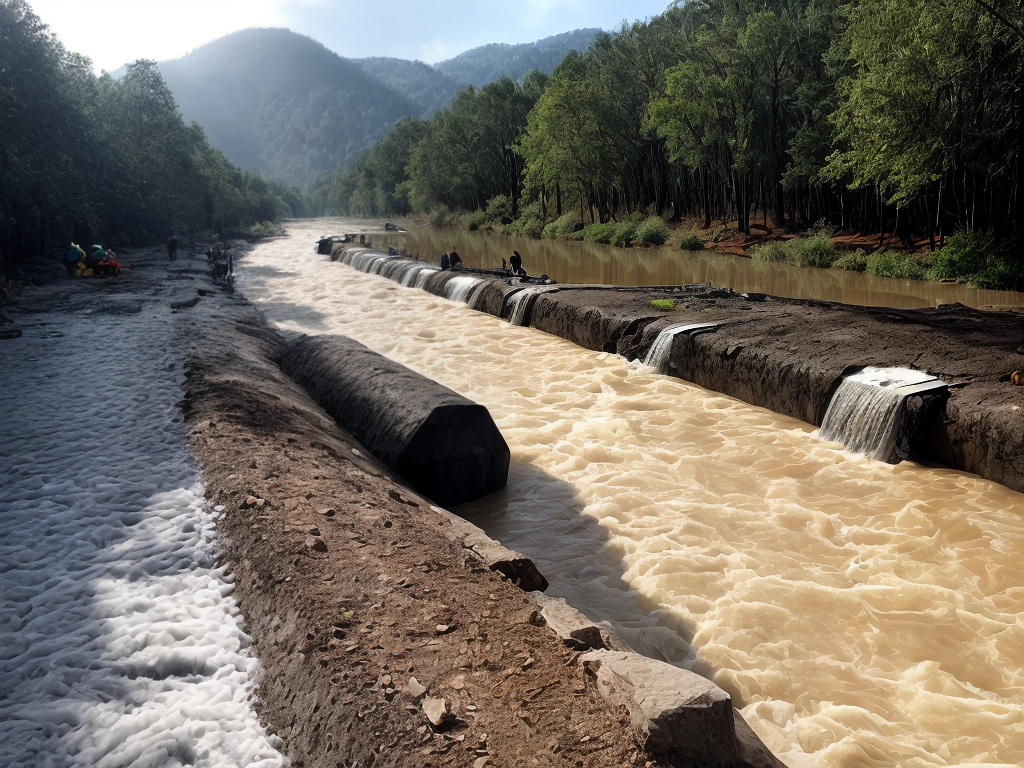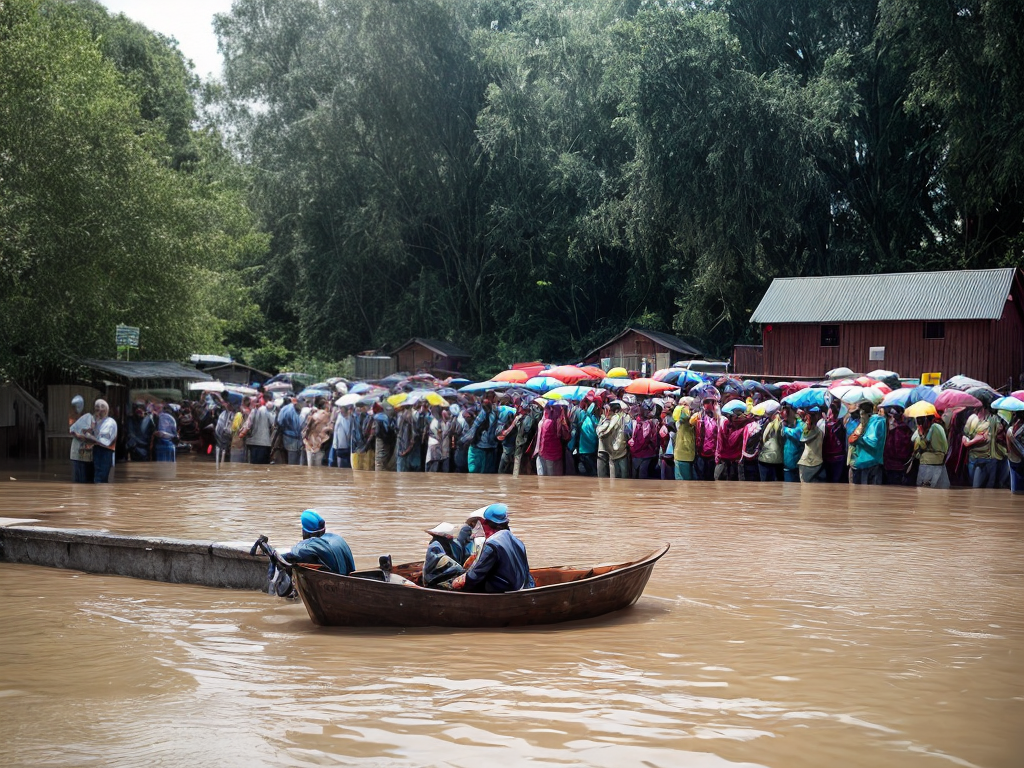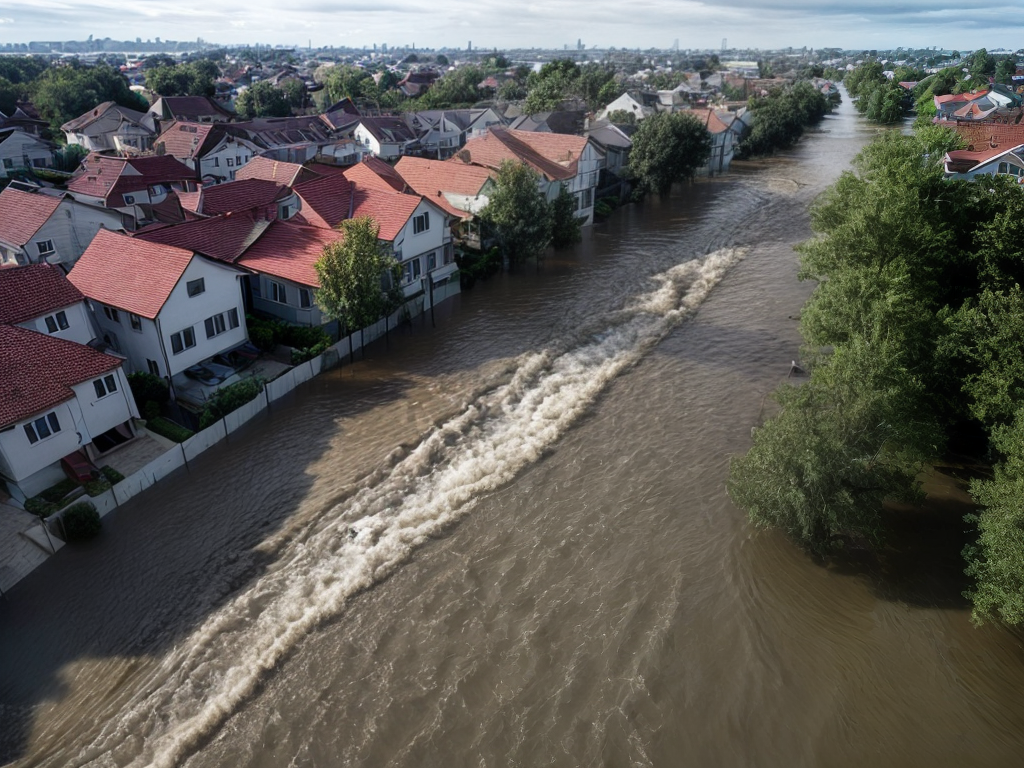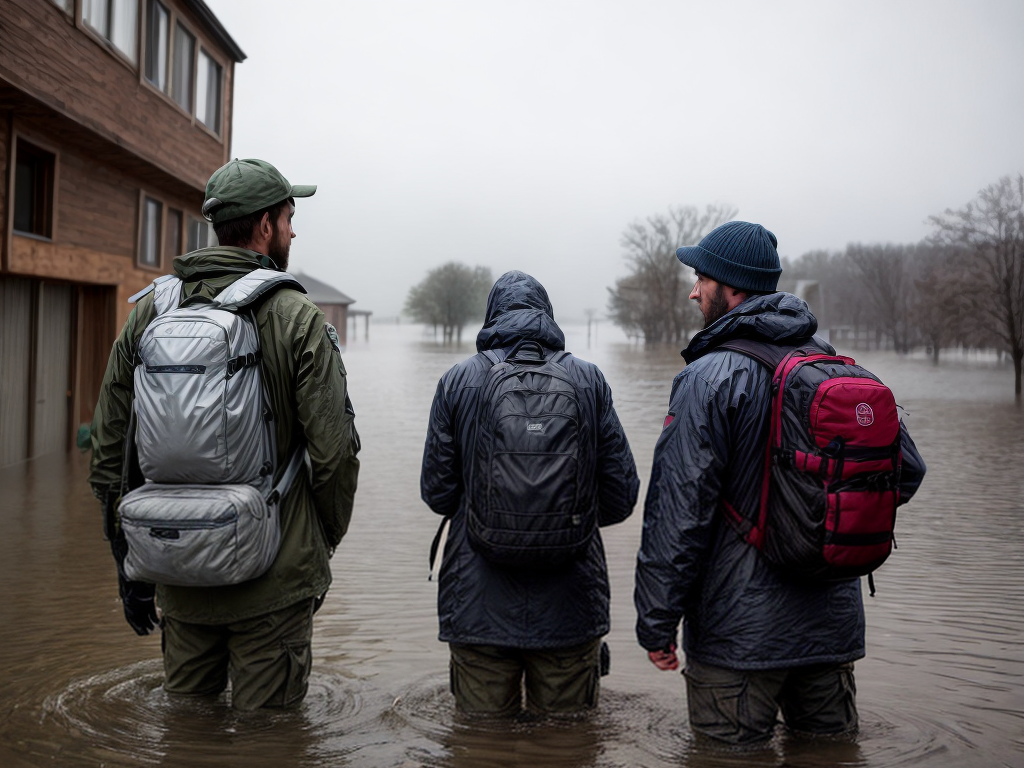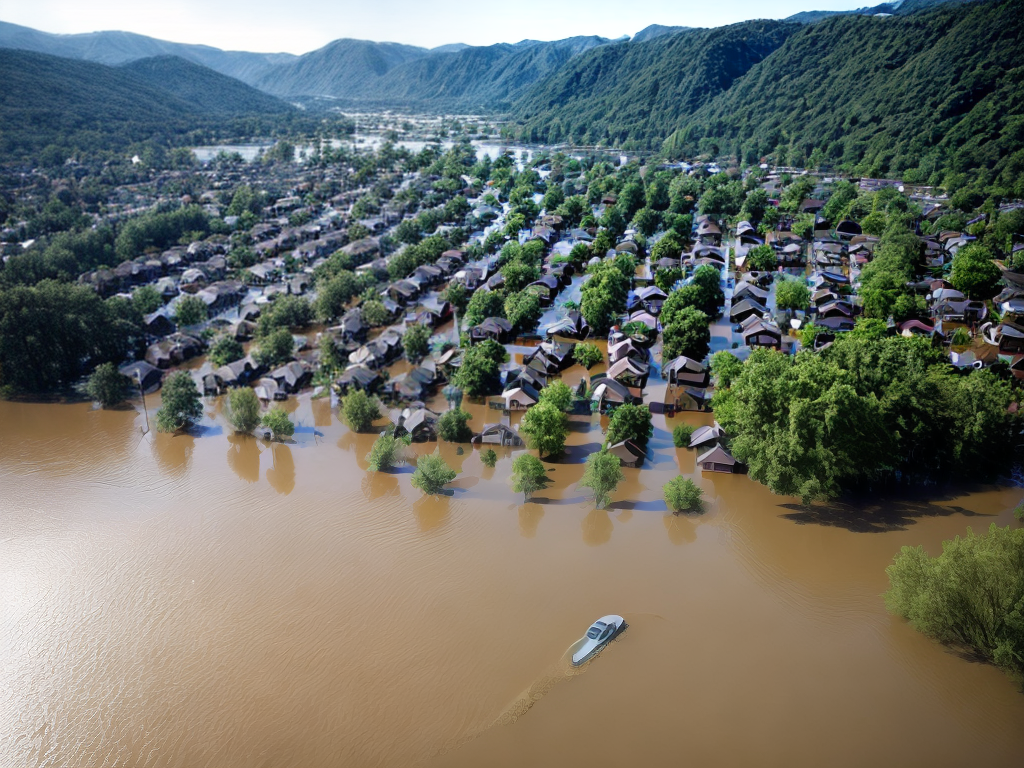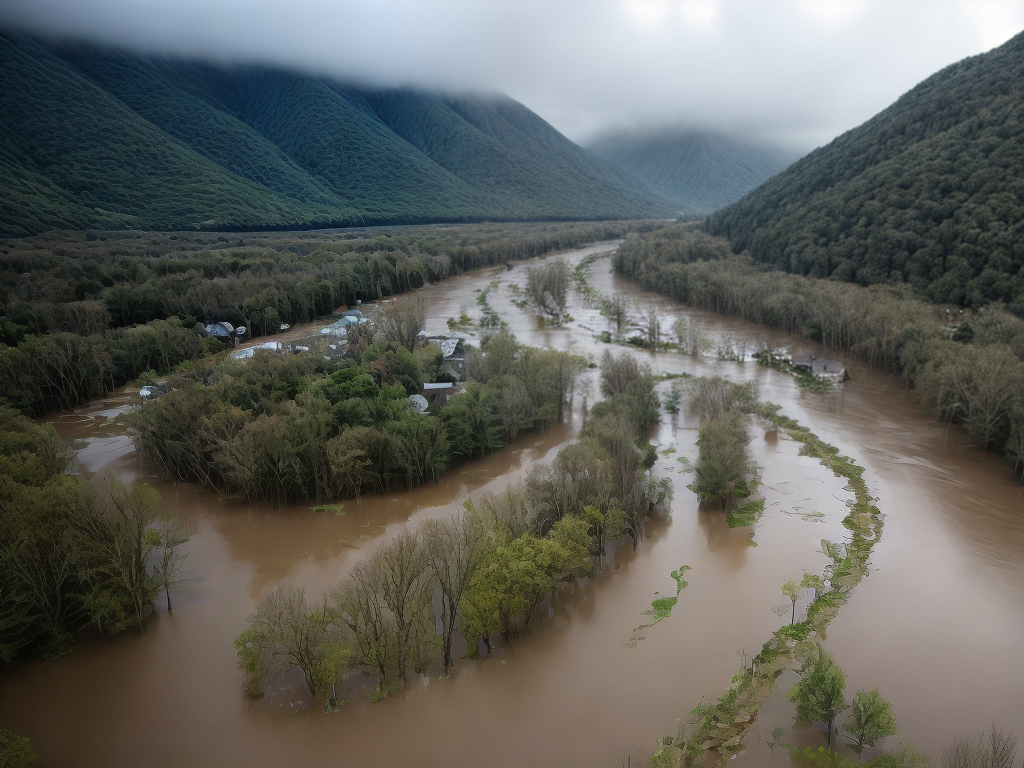
Collaborative projects in flood management have revolutionized the way we tackle this pressing issue. From government agencies teaming up with NGOs to harnessing the power of technology for accurate flood forecasting, these initiatives have brought about remarkable changes. The impact of such collaborations cannot be overstated, as they have not only improved our ability to mitigate the effects of floods but also saved countless lives and protected valuable infrastructure. But what exactly are these projects, and how are they making a difference? Let’s explore the various aspects of collaborative flood management and uncover the strategies that are transforming the way we approach this critical challenge.
Key Takeaways
- Strengthening collaboration between government agencies, NGOs, and other stakeholders is crucial in effective flood management.
- Engaging local communities in every stage of disaster management enhances the resilience and capacity of the community.
- Cross-sector partnerships and advancements in technology play a significant role in addressing the challenges of flooding.
- Innovative strategies, such as data analytics, watershed restoration, and community empowerment, contribute to more effective flood management.
Government Agencies and NGOs Joining Forces
Government agencies and NGOs are coming together to strengthen collaboration in flood management efforts. This is an exciting development that holds great promise for innovative solutions in addressing the challenges posed by flooding. Government partnerships and NGO collaborations have the potential to bring about significant improvements in flood management strategies.
One of the key advantages of government partnerships is the access to resources and expertise that they provide. By working together, government agencies and NGOs can pool their knowledge and skills to develop more effective flood management plans. This collaboration can lead to the implementation of innovative technologies and strategies that can mitigate the impact of floods and protect vulnerable communities.
Furthermore, NGO collaborations bring unique perspectives and grassroots knowledge to the table. NGOs often have a deep understanding of the local communities they serve and can provide valuable insights into the specific needs and challenges faced by these communities during flooding events. By partnering with NGOs, government agencies can tap into this local knowledge and tailor their flood management efforts accordingly, ensuring that they are effective and responsive to the needs of the people.
In addition to resource-sharing and local expertise, government partnerships and NGO collaborations can also foster greater community engagement and participation. By involving NGOs in the decision-making process, governments can ensure that the voices and concerns of the communities affected by flooding are heard and taken into account. This inclusive approach can lead to more sustainable and resilient flood management strategies that are accepted and supported by the community.
Community-Based Flood Preparedness Programs
By harnessing the insights gained from government partnerships and NGO collaborations, we can now explore the effectiveness of community-based flood preparedness programs. These programs, rooted in disaster risk reduction and flood preparedness strategies, empower communities to take an active role in mitigating the impact of floods. As we continue to innovate in this field, community-based approaches are proving to be crucial in building resilient societies.
Community-based flood preparedness programs involve engaging local communities in every stage of disaster management, from risk assessment to response and recovery. These programs recognize that communities have unique knowledge and resources that can contribute to effective flood preparedness. By involving community members in decision-making processes, these programs ensure that interventions are tailored to local needs and realities.
One innovative approach is the use of participatory mapping, where community members contribute their knowledge and experiences to create flood hazard maps. This not only helps identify flood-prone areas but also enables communities to develop appropriate response plans and evacuation routes. Additionally, community-based programs promote the establishment of early warning systems, which can be crucial in reducing the loss of lives and property during floods.
Furthermore, community-based flood preparedness programs foster a sense of ownership and responsibility among community members. By actively engaging in preparedness initiatives, individuals become more resilient and better equipped to respond to flood events. These programs also provide opportunities for capacity building, ensuring that communities have the necessary skills and knowledge to face future challenges.
Cross-Sector Partnerships for Flood Resilience
Collaborating with multiple sectors is essential for enhancing flood resilience in communities. In order to effectively address the challenges posed by floods, it is crucial to establish strong cross-sector partnerships that bring together government entities and private sector organizations. These partnerships can leverage the strengths and resources of each sector, leading to innovative solutions and better flood management strategies.
Government partnerships play a vital role in flood resilience. Governments have the authority and mandate to implement policies and regulations that promote flood preparedness and response. They can also provide financial support for infrastructure development, flood forecasting systems, and community education initiatives. By collaborating with governments, private sector organizations can tap into these resources and contribute their expertise, technology, and funding to enhance flood resilience efforts.
Private sector involvement is equally important in building flood resilience. Private sector organizations have access to cutting-edge technologies and innovative solutions that can be applied to flood management. They can also bring in financial investments and expertise in areas such as risk assessment, data analysis, and infrastructure development. By partnering with the private sector, governments can benefit from these capabilities and accelerate the implementation of effective flood resilience measures.
Cross-sector partnerships bring together the best of both worlds, enabling the exchange of knowledge, resources, and capabilities. By fostering collaboration between government entities and private sector organizations, communities can develop comprehensive flood resilience strategies that are innovative, efficient, and effective. These partnerships can lead to the development of early warning systems, improved infrastructure, and community engagement programs that empower individuals to take proactive measures against floods.
Harnessing Technology for Flood Forecasting
To effectively enhance flood resilience in communities, it is crucial to explore the potential of technology in flood forecasting. Technology advancements and data analytics have revolutionized the way we approach flood management, providing innovative solutions to mitigate the impact of floods. Here are three ways in which harnessing technology can make a difference in flood forecasting:
- Real-time monitoring: With the help of advanced sensors and remote sensing technologies, we can gather real-time data on rainfall, river levels, and soil moisture. This data can be analyzed using sophisticated algorithms and predictive models to accurately forecast flood events. By having access to up-to-date information, emergency responders and residents can be better prepared and make informed decisions to protect lives and property.
- Early warning systems: Technology has enabled the development of early warning systems that can provide timely alerts about potential flood threats. By analyzing historical data and weather patterns, these systems can anticipate flood events and issue warnings in advance. This allows communities to take proactive measures such as evacuations, deploying flood barriers, and securing critical infrastructure, ultimately minimizing the impact of floods.
- Decision support tools: Technology advancements have also led to the development of decision support tools that aid in flood management planning. These tools utilize data analytics and modeling techniques to assess flood risk, identify vulnerable areas, and simulate different scenarios. By leveraging these tools, policymakers and urban planners can make informed decisions regarding land use, infrastructure development, and emergency response strategies, ensuring a more resilient and adaptive approach to flood management.
Collaborative Watershed Management Initiatives
Our collective efforts in managing watersheds have proven to be instrumental in mitigating the impacts of floods. Through collaborative watershed management initiatives, we have been able to achieve effective flood management and restoration of our natural resources.
Government coordination plays a crucial role in these initiatives. By bringing together various stakeholders, including government agencies, local communities, and environmental organizations, we can ensure a holistic approach to watershed management. This coordination allows us to pool resources, share data and expertise, and implement comprehensive strategies for flood prevention and mitigation.
One key aspect of collaborative watershed management initiatives is watershed restoration. By restoring our watersheds, we can enhance their natural capacity to absorb and retain water, reducing the risk of flooding. Restoration efforts involve activities such as reforestation, wetland preservation, and erosion control. These measures not only help to prevent floods but also improve water quality, enhance biodiversity, and provide valuable habitats for wildlife.
Innovative techniques and technologies are also being utilized in collaborative watershed management. Remote sensing and GIS mapping enable us to identify vulnerable areas and develop targeted flood management strategies. Advanced modeling and forecasting systems help us to predict flood events more accurately, allowing for timely evacuation and emergency response. Additionally, community engagement and education programs empower individuals to become active participants in flood management, increasing resilience and fostering a sense of ownership.
Regional Cooperation in Flood Risk Reduction
Regional cooperation is essential for effective flood risk reduction. By working together across regions, we can pool resources, share expertise, and implement innovative solutions that can make a real difference in managing flood risks. Here are three reasons why regional cooperation is crucial in flood risk reduction:
- Enhanced Data Sharing: Regional cooperation allows for the exchange of valuable data and information between different areas. This data can help in understanding flood patterns, identifying vulnerable areas, and developing targeted mitigation strategies. Through citizen science in flood monitoring, local communities can actively contribute to data collection, providing real-time information that can be shared and utilized by neighboring regions.
- Collaborative Planning and Decision-Making: Regional cooperation fosters collaboration among various stakeholders, including government agencies, research institutions, and community organizations. By working together, these diverse groups can collectively identify flood risks, develop comprehensive flood management plans, and make informed decisions on the allocation of resources. This collaborative approach ensures that all perspectives are considered, leading to more effective and innovative solutions.
- Shared Resources and Expertise: In regions prone to flooding, the impacts of floods often extend beyond the boundaries of individual communities. Regional cooperation allows for the sharing of resources, such as flood control infrastructure, early warning systems, and emergency response capabilities. It also facilitates the exchange of knowledge and expertise, enabling regions to learn from each other’s experiences and adopt best practices in flood risk reduction.
Sharing Best Practices in Flood Response
Sharing best practices in flood response is essential for effective disaster management. To address the challenges posed by floods, communities and organizations must come together and exchange their experiences and knowledge. This collaborative approach allows us to learn from each other’s successes and failures, and ultimately improve our flood response strategies.
One important aspect of sharing best practices is community engagement. By involving the local community in flood response efforts, we can tap into their valuable insights and experiences. Communities often have a deep understanding of the unique challenges they face during floods and can provide valuable input on effective response measures. Engaging with the community also helps to build trust and foster a sense of ownership, leading to more effective and sustainable flood management practices.
Another key component of sharing best practices is conducting impact assessments. Understanding the impact of floods is crucial for developing effective response plans. By assessing the social, economic, and environmental impacts of past flood events, we can identify areas where our response strategies can be improved. Impact assessments also help us identify vulnerable populations and prioritize our efforts accordingly, ensuring that our response is equitable and inclusive.
To facilitate the sharing of best practices in flood response, it is important to establish platforms and networks where stakeholders can come together. This can be done through workshops, conferences, and online forums, where experts and practitioners can share their experiences, lessons learned, and innovative ideas. By fostering collaboration and knowledge exchange, we can collectively advance our understanding of flood response and develop more effective and innovative strategies to mitigate the impact of floods.
Collaborative Mapping for Flood Hazard Assessment
Let’s talk about the two key points when it comes to collaborative mapping for flood hazard assessment: data collection techniques and community engagement. When it comes to data collection, it is crucial to utilize various techniques such as remote sensing, GIS, and crowd-sourced data to gather accurate and comprehensive information. Additionally, involving the local community in the mapping process fosters a sense of ownership, enhances local knowledge, and ensures that the assessment reflects the realities and needs of the affected areas.
Data Collection Techniques
Collaborative mapping is an effective data collection technique for assessing flood hazards. It allows for the involvement of multiple stakeholders, fostering a sense of community and shared responsibility. Here are three reasons why collaborative mapping is an innovative approach to data collection for flood hazard assessment:
- Unconventional data sources: Collaborative mapping taps into a wide range of data sources that may not be traditionally considered, such as social media posts, citizen reports, and crowd-sourced data. This allows for a more comprehensive and real-time understanding of flood hazards.
- Participatory monitoring: Collaborative mapping encourages active participation from local communities, empowering them to contribute their knowledge and observations. By involving community members in the data collection process, it promotes a sense of ownership and engagement in flood management efforts.
- Innovation-driven approach: Collaborative mapping leverages technology and digital tools to collect, analyze, and visualize data. This innovative approach not only improves the efficiency and accuracy of data collection but also enables the development of advanced flood hazard assessment models and predictive analytics.
Community Engagement
To further explore the benefits of collaborative mapping for flood hazard assessment, let’s now focus on the crucial aspect of community engagement. Community empowerment and grassroots initiatives play a vital role in enhancing flood management efforts. By involving the community in the mapping process, we can tap into their local knowledge and expertise, resulting in more accurate and comprehensive flood hazard assessments. This not only fosters a sense of ownership and responsibility among community members but also promotes a culture of resilience and innovation. Through collaborative mapping, individuals and communities become active participants in flood management, contributing to the development of effective strategies and solutions. By empowering communities and encouraging grassroots initiatives, we can create a more inclusive and sustainable approach to flood management.
| Community Engagement Benefits | Collaborative Mapping for Flood Hazard Assessment |
|---|---|
| Community empowerment | Increased accuracy and comprehensiveness |
| Grassroots initiatives | Local knowledge and expertise |
| Ownership and responsibility | Resilience and innovation |
| Inclusive approach | Effective strategies and solutions |
| Sustainable flood management | Active community participation |
Public-Private Collaborations in Flood Protection
Public-private collaborations in flood protection have proven to be successful in addressing the challenges posed by flooding. These collaborations have led to the development of innovative strategies that aim to protect communities from the devastating effects of floods. By combining the resources and expertise of both the public and private sectors, these collaborative efforts have had a significant impact in enhancing flood resilience and reducing the risks associated with flooding.
Successful Public-Private Collaborations
One key factor in the successful management of floods is the effective collaboration between public and private entities. Government-private sector partnerships have proven to be instrumental in implementing innovative flood control measures. Here are three examples of successful public-private collaborations that have made a significant difference:
- The development of smart flood monitoring systems that utilize advanced sensor technologies to provide real-time data on water levels, enabling early warning systems and prompt response measures.
- Public-private partnerships in the construction industry have led to the implementation of innovative flood-resistant building techniques and materials, improving the resilience of infrastructure in flood-prone areas.
- Collaborations between insurance companies and government agencies to create innovative flood insurance policies that incentivize property owners to adopt flood prevention measures, reducing the overall impact of flood events.
Innovative Flood Protection Strategies
In our efforts to explore innovative flood protection strategies, collaborations between public and private entities have played a pivotal role. By joining forces, we have been able to develop and implement cutting-edge solutions that address the challenges of flood management. Two key areas of focus in these collaborations are the use of smart flood sensors and the integration of green infrastructure.
Smart flood sensors have revolutionized flood monitoring and early warning systems. These sensors can detect changes in water levels and provide real-time data to authorities, enabling them to take immediate action. By leveraging technology, we can now respond more effectively to flood events, minimizing the damage and protecting lives.
Another innovative strategy is the incorporation of green infrastructure. This approach involves using natural or nature-based features to manage and mitigate floods. Examples of green infrastructure include wetlands, green roofs, and permeable pavements. These features help to absorb and retain water, reducing the risk of flooding and enhancing the resilience of communities.
Impact of Collaborative Efforts
Our collaborative efforts have yielded a significant impact on flood protection, with public and private entities working together to develop and implement innovative strategies. Through our community empowerment initiatives and collaborative innovation, we have seen remarkable results in flood management. Here are three ways our collaborative efforts have made a difference:
- Enhanced early warning systems: By combining our resources and expertise, we have developed advanced technologies and systems that provide real-time updates and alerts to communities at risk of flooding. This has enabled timely evacuation and minimized the loss of life and property.
- Infrastructure improvements: Through our collaboration, we have been able to invest in and upgrade critical infrastructure such as levees, floodwalls, and drainage systems. These improvements have significantly reduced the impact of flooding and enhanced the resilience of our communities.
- Education and awareness programs: Our collaborative efforts have enabled us to implement comprehensive education and awareness programs that empower communities to take proactive measures in flood protection. By equipping individuals with the knowledge and tools they need, we are fostering a culture of resilience and ensuring long-term flood management success.
Together, we are making a tangible difference in flood protection, transforming the way we approach and mitigate the risks associated with floods.
Citizen Science in Flood Monitoring
Collaborating with citizens in flood monitoring significantly enhances the effectiveness and efficiency of our flood management efforts. In today’s world, where innovation is highly valued, citizen science involvement and community-driven monitoring have emerged as powerful tools in flood management. By actively involving citizens in monitoring and data collection, we can tap into a vast network of individuals who can contribute valuable information and insights. This collaborative approach not only empowers communities to take an active role in flood management but also allows us to gather real-time data on flood events more efficiently.
One of the key benefits of citizen science involvement in flood monitoring is the ability to expand our monitoring capabilities. With the help of citizens, we can monitor a larger area and gather data from various locations simultaneously. This not only provides us with a more comprehensive understanding of the flood situation but also enables us to respond more effectively to changing conditions.
Moreover, citizen science involvement promotes community engagement and resilience. By actively participating in flood monitoring, citizens become more aware of the risks and impacts of flooding in their communities. This knowledge empowers them to take proactive measures to mitigate the effects of flooding, such as implementing early warning systems or developing flood-resistant infrastructure.
Community-driven monitoring also fosters innovation in flood management. By involving citizens in the data collection process, we can tap into their local knowledge and expertise. This collaborative approach encourages the development of new technologies, methodologies, and solutions that are tailored to the specific needs and challenges of each community.
Collaborative Research for Flood Prevention Strategies
By harnessing the power of collaborative research, we can develop effective flood prevention strategies that build upon the insights gained from citizen science involvement and community-driven monitoring. This approach allows us to leverage the collective expertise and resources of communities, academia, and industry, enabling us to tackle the challenges of flood management in innovative ways. Here are three reasons why community-led flood prevention and academic-industry partnerships are essential for developing effective strategies:
- Local knowledge and engagement: Community-led flood prevention initiatives empower local residents to take an active role in managing flood risks. Their intimate understanding of the local environment, combined with their commitment to safeguarding their communities, can provide invaluable insights into flood-prone areas and potential solutions. Through collaborative research, we can tap into this wealth of knowledge and engage community members in the co-design and implementation of flood prevention strategies.
- Interdisciplinary expertise: Effective flood prevention requires a multidisciplinary approach that combines the expertise of various disciplines, including engineering, hydrology, urban planning, and social sciences. Academic-industry partnerships bring together researchers, practitioners, and policymakers, fostering collaboration and knowledge exchange. By harnessing the diverse perspectives and skills of these stakeholders, we can develop holistic flood prevention strategies that address the complex interplay of physical, social, and environmental factors.
- Innovation and scalability: Collaborative research enables us to explore new technologies, methodologies, and approaches to flood prevention. By bringing together academia and industry, we can leverage cutting-edge technologies, such as remote sensing, artificial intelligence, and data analytics, to enhance our understanding of flood dynamics and develop innovative solutions. This collaboration also facilitates the scalability of flood prevention strategies, ensuring that successful approaches can be replicated and applied in different contexts, thereby maximizing their impact.
Engaging Local Communities in Flood Mitigation
When it comes to flood mitigation, engaging local communities is crucial. By involving residents in the planning and implementation of flood prevention measures, we can tap into their knowledge, experiences, and resources. This not only empowers the community but also builds resilience, as locals become active participants in protecting their neighborhoods from future flood events.
Community Involvement in Mitigation
To effectively mitigate the risks of flooding, it is crucial to actively engage local communities in the process. Community participation and grassroots initiatives play a vital role in flood mitigation efforts, fostering a sense of ownership and responsibility among residents. Here are three ways in which community involvement can make a difference:
- Empowerment: Engaging local communities empowers individuals to take an active role in safeguarding their homes and neighborhoods against floods. By providing them with the necessary knowledge, resources, and support, they can become agents of change.
- Innovation: Local communities often hold valuable knowledge and insights about their surroundings. By involving them in flood mitigation efforts, we can tap into their innovative ideas and solutions, leading to more effective and sustainable strategies.
- Resilience: Building strong community networks fosters resilience in the face of flooding. Through collaboration and collective action, local communities can develop strategies to reduce vulnerability, adapt to changing conditions, and recover more quickly from flood events.
Empowering Local Residents
Engaging local communities in flood mitigation efforts empowers residents to actively contribute to safeguarding their homes and neighborhoods. Through participatory decision-making processes, community empowerment is fostered, allowing residents to have a meaningful say in flood management strategies and initiatives. This approach recognizes that local knowledge and lived experiences are invaluable resources in finding innovative solutions to address flood risks and enhance resilience. By involving residents in the decision-making process, we tap into their creativity and problem-solving abilities, leading to more effective and sustainable flood mitigation measures. Residents become active participants in shaping their futures, taking ownership of flood management projects, and working together with government agencies, NGOs, and other stakeholders. This collaborative approach not only strengthens the resilience of communities but also fosters a sense of unity and solidarity, creating a stronger and more resilient society as a whole.
Building Community Resilience
By involving local communities in flood mitigation efforts, we can build their resilience and empower them to actively contribute to safeguarding their homes and neighborhoods. Building community networks and promoting community-led solutions are essential in creating a more innovative approach to flood management. Here are three reasons why engaging local communities is crucial in building community resilience:
- Shared knowledge: Local communities possess valuable insights and traditional knowledge about their surroundings. By tapping into this collective wisdom, we can develop innovative strategies that are rooted in the local context.
- Increased awareness: Engaging with local communities helps raise awareness about flood risks and the importance of preparedness. This leads to a more informed and proactive approach to flood management.
- Strengthened social fabric: Building community networks fosters a sense of belonging and solidarity among residents. This social cohesion enables communities to come together and support each other during times of crisis.
International Cooperation for Flood Management
Our collaboration with international partners enhances flood management efforts and allows us to share valuable knowledge and resources. International partnerships play a crucial role in developing effective flood management strategies. By working together, we can leverage diverse perspectives, innovative technologies, and best practices from around the world to address the complex challenges posed by flooding.
Through international cooperation, we have access to a wide range of expertise and experiences. This enables us to learn from successful approaches implemented in different countries and adapt them to our own unique circumstances. For example, we have partnered with countries like the Netherlands, known for their advanced flood prevention measures, to exchange knowledge on innovative engineering techniques and sustainable water management strategies. These collaborations have proven invaluable in enhancing our ability to mitigate flood risks and build resilience in our communities.
Furthermore, international partnerships allow us to pool resources and share technologies. This enables us to develop and implement cutting-edge flood forecasting systems, early warning mechanisms, and flood control infrastructure. Collaborative efforts have led to the development of state-of-the-art flood modeling tools, remote sensing technologies, and real-time data collection methods. These advancements not only improve our ability to accurately predict and respond to flood events but also enable us to develop more efficient and cost-effective flood management strategies.
Collaborative Funding for Flood Infrastructure Projects
Collaborative funding is essential for the successful implementation of flood infrastructure projects. To tackle the increasing challenges posed by flooding, different stakeholders must come together and pool their resources. Through collaborative financing and public-private partnerships, innovative flood management solutions can be developed and implemented effectively. Here are three reasons why collaborative funding is crucial for flood infrastructure projects:
- Leveraging expertise and resources: Collaborative funding allows for the pooling of expertise and resources from various stakeholders, including government agencies, private companies, and non-profit organizations. This enables a more comprehensive approach to flood management, leveraging the strengths and capabilities of each partner. By combining financial resources, knowledge, and technology, innovative flood infrastructure projects can be realized.
- Reducing financial burden: Flood infrastructure projects require significant financial investment. Collaborative funding allows for the sharing of financial burdens among different stakeholders. By engaging public-private partnerships, the costs can be distributed more evenly, making flood infrastructure projects more feasible and financially sustainable.
- Promoting innovation: Collaborative funding encourages innovation in flood management. With different stakeholders involved, there is a greater diversity of ideas and approaches. This fosters an environment for innovative solutions to emerge, leading to more effective flood infrastructure projects. By bringing together different perspectives and expertise, collaborative funding enables the development of cutting-edge technologies and strategies to mitigate and manage floods.
Promoting Knowledge Exchange in Flood Management
Let’s explore how we can promote knowledge exchange in flood management. One way is through the use of knowledge-sharing platforms, where experts and stakeholders can share information, best practices, and lessons learned. Another approach is through collaborative research initiatives, where different organizations come together to research flood management strategies and solutions. Lastly, international flood conferences provide a platform for professionals from around the world to gather and exchange knowledge and experiences in the field of flood management.
Knowledge Sharing Platforms
Knowledge-sharing platforms play a crucial role in promoting the exchange of information and expertise in flood management. These platforms provide a space for data sharing and collaborative learning, enabling stakeholders to come together and share their knowledge and experiences. Here’s why knowledge sharing platforms are essential for innovation in flood management:
- Increased access to information: Knowledge sharing platforms allow for the dissemination of up-to-date and relevant information on flood management strategies, technologies, and best practices. This enables stakeholders to stay informed and make more informed decisions.
- Collaboration and collective problem-solving: These platforms facilitate collaboration among experts, practitioners, and policymakers, fostering a collective approach to problem-solving. By leveraging diverse perspectives and expertise, innovative solutions can be developed to address the complex challenges of flood management.
- Accelerated innovation: Through knowledge sharing platforms, ideas can be shared, tested, and refined at a faster pace. This helps to accelerate the innovation process, leading to the development of more effective flood management strategies and technologies.
Collaborative Research Initiatives
As we explore the realm of collaborative research initiatives, we can further enhance the knowledge exchange in flood management. One innovative approach is through citizen science, which involves involving the public in data collection, analysis, and decision-making processes. By engaging citizens in flood management efforts, we can tap into their local knowledge and expertise, while also fostering a sense of ownership and responsibility. Citizen science initiatives can provide valuable insights and data that can inform flood modeling, risk assessment, and mitigation strategies. Another avenue for collaboration is through public-private partnerships. By bringing together government agencies, private sector organizations, and academia, we can leverage diverse resources, expertise, and technologies to address the complex challenges of flood management. These partnerships foster innovation, accelerate the development of solutions, and promote more effective and sustainable flood management practices.
International Flood Conferences
International flood conferences serve as important platforms for fostering knowledge exchange and collaboration in flood management. These conferences bring together experts, researchers, and practitioners from around the world to discuss and share innovative ideas and solutions in the field of flood management. Here are three key reasons why international flood conferences are essential for promoting innovation in flood management:
- Sharing best practices: Participants have the opportunity to learn from successful flood management projects implemented in different regions, enabling them to adopt and adapt these practices in their contexts.
- International collaboration: The conferences facilitate networking and collaboration between professionals and organizations working on international flood forecasting and global flood risk assessment. This collaboration leads to the development of new approaches and technologies to better understand and manage flood risks.
- Exposure to cutting-edge research: International flood conferences provide a platform for researchers to present their latest findings and advancements in flood management. This exposure to cutting-edge research encourages innovation and drives the development of new and improved techniques and tools for effective flood management.

